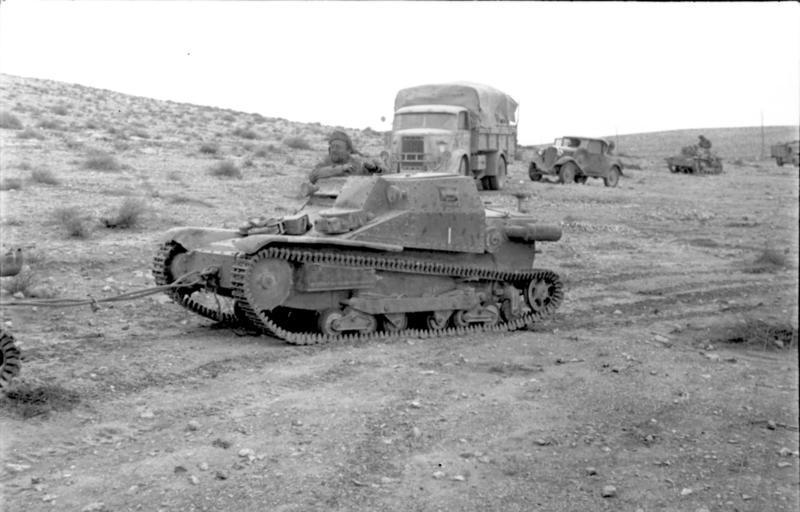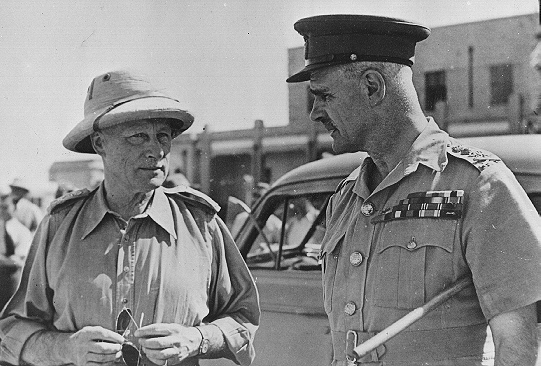|
Michael O'Moore Creagh
Major General Sir Michael O'Moore Creagh, (16 May 1892 – 14 December 1970) was a British Army officer who served in both the world wars. He commanded the 7th Armoured Division, the Desert Rats, between 1939 and 1941. Early life and military career Creagh was born on 16 May 1892 to O'Moore Creagh, a Victoria Cross recipient and officer in the British Indian Army, and his second wife Elizabeth (née Reade). Educated at Wellington College, he entered the Royal Military College, Sandhurst, and was then commissioned into the 7th (Queen's Own) Hussars in 1911. By the end of the First World War, Creagh had served as an aide de camp to the divisional commander Home Forces (1914–15), as a staff captain in France (1917–18) and a brigade major (1918–19). Creagh stayed in the army after the war, attending the Staff College, Camberley from 1924 to 1925, and commanded the 15th/19th The King's Royal Hussars from 1934 to 1938. Second World War On 4 December 1939, three months af ... [...More Info...] [...Related Items...] OR: [Wikipedia] [Google] [Baidu] |
British Indian Army
The British Indian Army, commonly referred to as the Indian Army, was the main military of the British Raj before its dissolution in 1947. It was responsible for the defence of the British Indian Empire, including the princely states, which could also have their own armies. As quoted in the Imperial Gazetteer of India, "The British Government has undertaken to protect the dominions of the Native princes from invasion and even from rebellion within: its army is organized for the defence not merely of British India, but of all possessions under the suzerainty of the King-Emperor." The Indian Army was an important part of the British Empire's forces, both in India and abroad, particularly during the First World War and the Second World War. The term ''Indian Army'' appears to have been first used informally, as a collective description of the Presidency armies, which collectively comprised the Bengal Army, the Madras Army and the Bombay Army, of the Presidencies of British ... [...More Info...] [...Related Items...] OR: [Wikipedia] [Google] [Baidu] |
Cyrenaica
Cyrenaica ( ) or Kyrenaika ( ar, برقة, Barqah, grc-koi, Κυρηναϊκή ��παρχίαKurēnaïkḗ parkhíā}, after the city of Cyrene), is the eastern region of Libya. Cyrenaica includes all of the eastern part of Libya between longitudes E16 and E25, including the Kufra District. The coastal region, also known as ''Pentapolis'' ("Five Cities") in antiquity, was part of the Roman province of Crete and Cyrenaica, later divided into ''Libya Pentapolis'' and ''Libya Sicca''. During the Islamic period, the area came to be known as ''Barqa'', after the city of Barca. Cyrenaica became an Italian colony in 1911. After the 1934 formation of Libya, the Cyrenaica province was designated as one of the three primary provinces of the country. During World War II, it fell under British military and civil administration from 1943 until 1951, and finally in the Kingdom of Libya from 1951 until 1963. The region that used to be Cyrenaica officially until 1963 has formed s ... [...More Info...] [...Related Items...] OR: [Wikipedia] [Google] [Baidu] |
Western Desert Force
The Western Desert Force (WDF) was a British Army formation active in Egypt during the Western Desert Campaign of the Second World War. On 17 June 1940, the headquarters of the British 6th Infantry Division was designated as the Western Desert Force. The formation consisted of the British 7th Armoured Division and the 4th Indian Infantry Division. The force was commanded by Major-General Richard Nugent O'Connor. In September 1940, at the time of the Italian invasion of Egypt, the Western Desert Force consisted of roughly 36,000 soldiers and about 65 tanks. From early December 1940 to February 1941, during Operation Compass, the exploits of the Western Desert Force earned a parody of British Prime Minister Winston Churchill's famous quote, "Never has so much been owed by so many, to so few." So many Italians were captured by the Western Desert Force that Anthony Eden said, "Never has so much been surrendered by so many, to so few." From 14 December, the 6th Australian Divis ... [...More Info...] [...Related Items...] OR: [Wikipedia] [Google] [Baidu] |
Counterattack
A counterattack is a tactic employed in response to an attack, with the term originating in " war games". The general objective is to negate or thwart the advantage gained by the enemy during attack, while the specific objectives typically seek to regain lost ground or destroy the attacking enemy (this may take the form of an opposing sports team or military units). A saying, attributed to Napoleon Bonaparte illustrate the tactical importance of the counterattack : "the greatest danger occurs at the moment of victory". In the same spirit, in his Battle Studies, Ardant du Pic noticed that "he, general or mere captain, who employs every one in the storming of a position can be sure of seeing it retaken by an organised counter-attack of four men and a corporal". A counterattack is a military tactic that occurs when one side successfully defends off the enemy’s attack and begins to push the enemy back with an attack of its own. In order to perform a successful counterattack, ... [...More Info...] [...Related Items...] OR: [Wikipedia] [Google] [Baidu] |
Operation Compass
Operation Compass (also it, Battaglia della Marmarica) was the first large British military operation of the Western Desert Campaign (1940–1943) during the Second World War. British, Empire and Commonwealth forces attacked Italian forces of the 10th Army (Marshal Rodolfo Graziani) in western Egypt and Cyrenaica, the eastern province of Libya, from December 1940 to February 1941. The Western Desert Force (WDF) (Lieutenant-General Richard O'Connor) with about advanced from Mersa Matruh in Egypt on a five-day raid against the Italian positions of the 10th Army, which had about in fortified posts around Sidi Barrani in Egypt and in Cyrenaica. The WDF swiftly defeated the Italians in their fortified posts and at Sidi Barrani and then exploited the success, forcing the rest of the 10th Army out of Egypt and capturing the ports along the Libyan coast. The 10th Army was cut off as it retreated towards Tripolitania and defeated at the Battle of Beda Fomm, the remnants being pu ... [...More Info...] [...Related Items...] OR: [Wikipedia] [Google] [Baidu] |
Sidi Barrani
Sidi Barrani ( ar, سيدي براني ) is a town in Egypt, near the Mediterranean Sea, about east of the Egypt–Libya border, and around from Tobruk, Libya. Named after Sidi es-Saadi el Barrani, a Senussi sheikh who was a head of its Zawiya, the village is mainly a Bedouin community. It has food, gasoline outlets and one small hotel, but virtually no tourist activity or visited historical curiosities. It is the site of an Egyptian Air Force base. History Located close to the Roman city of Zygra, in the Roman province of Libya Inferior, Sidi Barrani is often mentioned in historical records to mark the limit of the initial Italian invasion of Egypt from Libya. The Italian Tenth Army built a series of forts in the vicinity. American Field Service volunteers, providing ambulance services and serving with the British 8th Army were based in the area, in June 1942, 30 miles east of Sidi Barrani. Sidi Barrani was a destination during the total solar eclipse on O ... [...More Info...] [...Related Items...] OR: [Wikipedia] [Google] [Baidu] |
Italian Tenth Army
The 10th Army ( it, 10ª Armata) was a field army of the Royal Italian Army, which fought in World War I and in Italian North Africa during World War II. World War I Formation After the Battle of Caporetto (November 1917) the Italian Army (Regio Esercito) was reorganized by Armando Diaz. In the summer of 1918 (after the Battle of the Solstice) the Command continued to modify these changes and in preparation for the Italian Offensive planned for October 1918, the new 10th Italian Army was formed on 14 October. It was a British–Italian Army under command of the Earl of Cavan. It consisted of * 1 Italian Army corps, the XI Corps (Italian) (Corpo d'Armata) of Lt. General Giuseppe Paolini. ** 37th division of Maj. General Giovanni Castagnola (Brigata Macerata of Brig. General Florenzio Tagliaferri, 121st and 122nd Infantry Regiments; Brigata Foggia of Brig. General Raffaele Radini Tedeschi, 280th and 281st Infantry Regiments) ** 23rd Bersaglieri Division of Lt. General Gustavo Far ... [...More Info...] [...Related Items...] OR: [Wikipedia] [Google] [Baidu] |
Archibald Wavell, 1st Earl Wavell
Field Marshal (United Kingdom), Field Marshal Archibald Percival Wavell, 1st Earl Wavell, (5 May 1883 – 24 May 1950) was a senior officer of the British Army. He served in the Second Boer War, the Bazar Valley Campaign and the First World War, during which he was wounded in the Second Battle of Ypres. In the Second World War, he served initially as Commander-in-Chief Middle East Command, Middle East, in which role he led British forces to victory over the Kingdom of Italy, Italians in western Egypt and eastern Libya during Operation Compass in December 1940, only to be defeated by the German Army (Wehrmacht), German Army in the Western Desert Campaign, Western Desert in April 1941. He served as Commander-in-Chief, India, from July 1941 until June 1943 (apart from a brief tour as American-British-Dutch-Australian Command, Commander of ABDACOM) and then served as Governor-General of India, Viceroy of India until his retirement in February 1947. Early life Born the son of Archiba ... [...More Info...] [...Related Items...] OR: [Wikipedia] [Google] [Baidu] |
Percy Hobart
Major General Sir Percy Cleghorn Stanley Hobart, (14 June 1885 – 19 February 1957), also known as "Hobo", was a British military engineer noted for his command of the 79th Armoured Division during the Second World War. He was responsible for many of the specialised armoured vehicles ("Hobart's Funnies") that took part in the invasion of Normandy and later actions. Early life Hobart was born in Naini Tal, British India, to Robert T. Hobart (of the Indian Civil Service), and Janetta (née Stanley). His mother was born in County Tyrone and lived at Roughan Park, near Newmills, between Cookstown and Dungannon. She married Robert Hobart in Tullaniskin Parish Church, Dungannon, on 7 October 1880. In his youth, Hobart studied history, painting, literature and church architecture. He was educated at Temple Grove School and Clifton College, and in 1904 he graduated from the Royal Military Academy, Woolwich and was commissioned into the Royal Engineers. He was first sent to India, ... [...More Info...] [...Related Items...] OR: [Wikipedia] [Google] [Baidu] |
Staff College, Camberley
Staff College, Camberley, Surrey, was a staff college for the British Army and the presidency armies of British India (later merged to form the Indian Army). It had its origins in the Royal Military College, High Wycombe, founded in 1799, which in 1802 became the Senior Department of the new Royal Military College. In 1858 the name of the Senior Department was changed to "Staff College", and in 1870 this was separated from the Royal Military College. Apart from periods of closure during major wars, the Staff College continued to operate until 1997, when it was merged into the new Joint Services Command and Staff College. The equivalent in the Royal Navy was the Royal Naval Staff College, Greenwich, and the equivalent in the Royal Air Force was the RAF Staff College, Bracknell. Origins In 1799, Colonel John Le Marchant submitted a proposal to the Duke of York, the Commander-in-Chief of the Forces, for a Royal Military College. A private officer training school, based on the ... [...More Info...] [...Related Items...] OR: [Wikipedia] [Google] [Baidu] |





